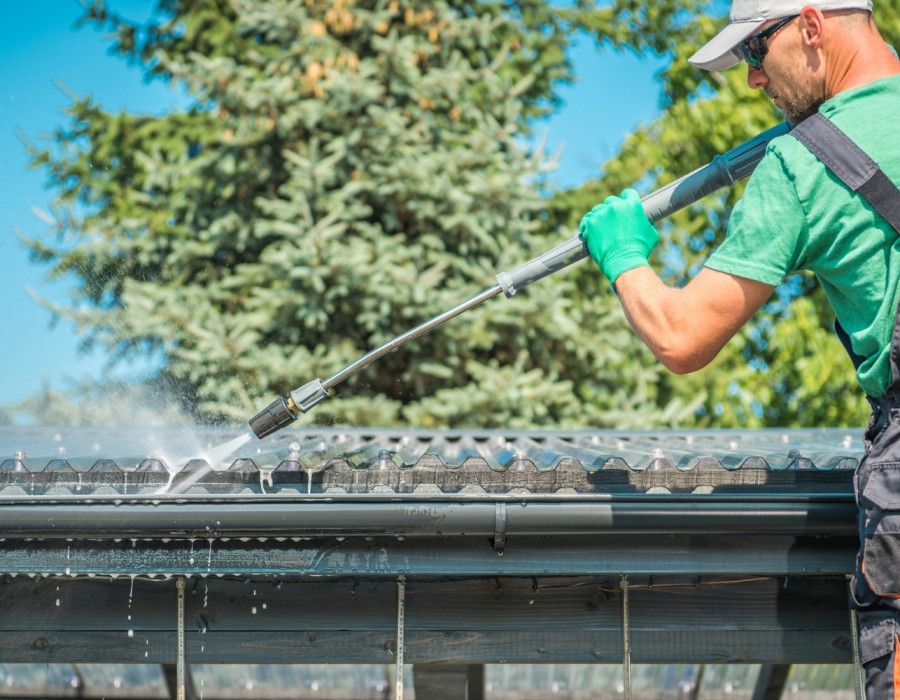Introduction:
The importance of maintaining a properly functioning roof and gutter system extends far beyond the protection it provides to a home or structure. In reality, the environmental benefits of a well maintained roof and gutter system are frequently overlooked. This article digs into the different ways in which a well-maintained roof and gutter system contribute to environmental sustainability, highlighting the positive effects on local ecosystems, water conservation, energy efficiency, and overall ecological balance.
1: Mitigating Urban Heat Islands
One of the most important environmental benefits of a well-maintained roof is its ability to reduce urban heat islands. Heat is trapped and radiated by urban areas with large concrete surfaces, resulting in higher temperatures. A well-insulated and reflecting roof can assist reduce heat absorption and hence reduce the urban heat island effect. This not only improves residents' comfort but also has a favourable impact on energy usage and air quality.
2: Rainwater Harvesting and Water Conservation
Rainwater harvesting, an ecologically friendly activity that helps save water resources, relies heavily on gutters. Homeowners may use collected rainwater for different reasons such as watering gardens or flushing toilets by channeling rainfall away from the roof and into storage devices such as rain barrels or underground tanks. This not only lessens the demand on municipal water resources, but it also eliminates runoff, which may transfer contaminants into nearby bodies of water.
3: Preventing Water Damage and Erosion
A well-maintained gutter system is critical for minimising water damage to the foundation and surrounding landscaping of a structure. Water can gather around the foundation without sufficient drainage, causing structural concerns and soil erosion. Local ecosystems are impacted by erosion because it disrupts natural drainage patterns and transports debris and contaminants into rivers and streams. A well-maintained roof and gutter system helps to reduce these environmental concerns by properly controlling water flow.
4: Reducing Energy Consumption
The roofing materials used and the general condition of a roof can have a major influence on a building's energy efficiency. A well-insulated roof aids in temperature regulation, decreasing the need for excessive heating or cooling. This results in lower energy usage and fewer greenhouse gas emissions from energy production. A well-maintained roof has environmental benefits that extend beyond the structure itself, since reduced energy consumption adds to a lower carbon footprint.
5: Extending Roof Lifespan and Reducing Waste
Regular care, inspections, and timely repairs help to extend the life of a roof, lowering the frequency with which it must be replaced. This not only saves cash but also reduces the environmental effect of roofing material manufacture, shipping, and disposal. Homeowners may contribute to sustainable resource management and waste reduction by taking a proactive approach to roof care.
6: Biodiversity and Habitat Preservation
Green roofs, which include growing flora on rooftops, have grown in popularity due to the environmental advantages they provide. These roofs support urban biodiversity by providing habitat for birds, insects, and other species. Green roofs also absorb rainfall, minimise runoff, and enhance air quality by trapping pollutants. The use of green roofs into urban design can improve an area's overall ecological balance.
7: Air Quality Improvement
By lowering the urban heat island effect and promoting green roof efforts, a well-maintained roof indirectly contributes to improved air quality. Because of pollution and the heat island effect, urban areas frequently have poor air quality. Reflective roofing materials and green roofs aid in reducing this problem by absorbing pollutants and boosting airborne particle filtration. As a result, air quality around well-maintained roofs tends to be better, helping both inhabitants' and nearby ecosystems' health.
8: Carbon Sequestration and Climate Change Mitigation
Green roofs, in particular, play an important role in carbon sequestration and the mitigation of climate change. The plant on these roofs collects CO2 from the atmosphere and serves as a natural carbon sink. This technique contributes to worldwide efforts to address climate change by mitigating the impact of greenhouse gas emissions. Green roofs also offer cooling through evapotranspiration, lowering the overall carbon footprint of the structure and its surroundings.
9: Stormwater Management and Flood Prevention
Stormwater management relies heavily on properly functioning gutters and a well-maintained roof. During heavy rain, an effective gutter system conducts water away from the base of the structure, reducing flooding and water damage. This not only protects the structure but also neighbouring water bodies from excessive runoff, which might cause flooding. A well-maintained sydney gutter and roof system helps to the overall resilience of communities against extreme weather events by properly managing rainwater.
10: Sustainable Roofing Materials
The roofing materials used have a direct influence on a building's environmental footprint. Sustainable roofing materials, such as recycled metal, recovered wood, and eco-friendly composite materials, help to save resources and eliminate the need for new, energy-intensive manufacturing. Homeowners and builders may match their decisions with sustainability goals by using ecologically friendly roofing materials, improving the overall environmental health of their communities.
Conclusion:
To summarise, the environmental benefits of a well-maintained roof and gutter system are numerous and extensive. The benefits extend beyond the immediate surroundings of the building, from decreasing urban heat islands to promoting water conservation, enhancing air quality, supporting biodiversity, and helping to mitigate climate change mitigation. Homeowners, builders, and urban planners may help develop sustainable practices that address environmental concerns and contribute to a more resilient and ecologically balanced future.
We can work together to create more sustainable and resilient communities by recognising the interdependence of built infrastructure with the natural environment. The environmental advantages of well-maintained roofs and gutters highlight the need of incorporating environmentally friendly practices into building design, construction, and maintenance, paving the way for a greener and healthier urban landscape.





Comments